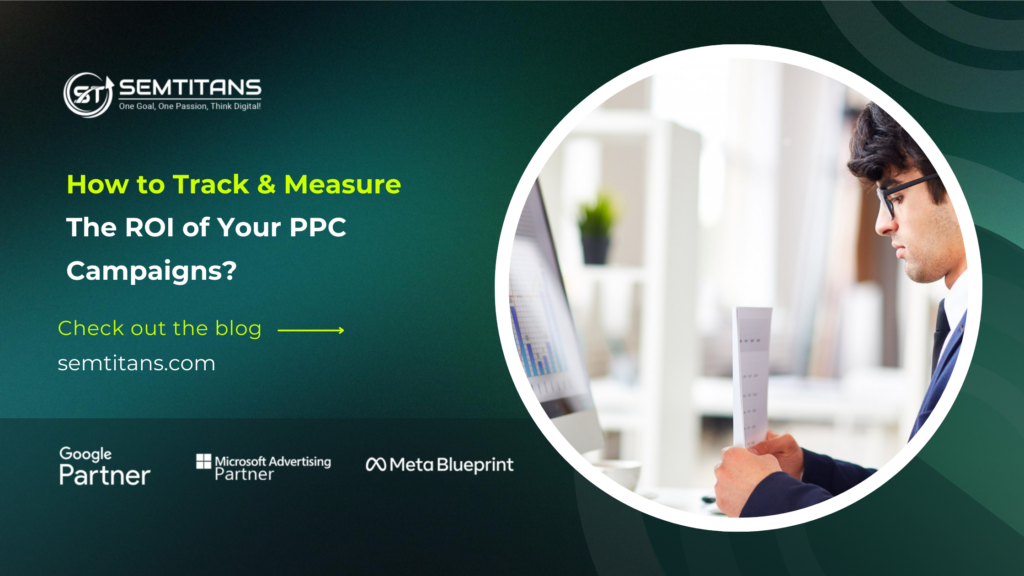
When it comes to digital marketing, brands and businesses worldwide use pay-per-click advertising as a crucial part of their strategy. Did you know that, as per Aov Up, companies can increase their brand awareness by upto 80% using PPC marketing? This statistic strongly indicates how important pay-per-click advertising is to grow your business.
However, PPC tends to be an expensive strategy, and brands need to pay a direct fee for each ad click. Due to its direct action cost, it is essential to track how much you are earning from your PPC investments. In this blog, we will discuss how to track and measure your PPC investments in the best ways.
Table of Contents
ToggleA] What is Pay-per-click Marketing, and How to Measure its ROI?
PPC marketing is a form of web marketing in which the advertiser pays each time a user clicks on an ad. Most PPC ads are found on search engines, websites, and other social networking sites. Advertisers bid for the worth of a click, and the price bid can influence the location of the ad placed. The platform operates on a pay-per-click model, where the advertiser has to pay when a visitor follows the link to the advertiser’s website.
PPC ROI is defined as the ability to apportion profit and overall revenue to the outcomes of the advertising campaigns you run. The following formula can be used to measure the return on investment (ROI) of a pay-per-click (PPC) campaign –
- Start by subtracting the total cost of a PPC campaigns from the revenue generated.
- Then, divide the resulting difference by the total campaign cost.
- Finally, multiply the result by 100 for an ROI percentage, determining your PPC returns.
PPC ROI (%) = (total revenue – total expenses) / total expenses x 100
B] Essential Tips to Help Track PPC Advertising ROI:
Many PPC marketers struggle to track their ROI for many reasons, like changes to tracking and data privacy. This is why many companies use pay-per-click management services to help them evaluate their campaigns and decide whether the returns are positive.
Here are some tried-and-tested techniques that will help you track your PPC campaign’s ROI and overcome the struggles –
- Establish Revenue Goals
Before tracking ROI, you must establish clear goals to work towards. For instance, your goal can be to increase profits by 10% or bring the revenue to 100,000 $. You can set these goals on a weekly or monthly basis to ensure your PPC returns are contributing to the overall business objective.
- Track User Journeys
After generating a concise goal, you must keep track of the contact info for the leads generated via PPC. Tracking individual users can provide a detailed view of your customer’s journey and demonstrate ROI. Although the customer journey is becoming more complex due to multiple touchpoints, you can use tools like Ruler to track each anonymous visitor and their subsequent visits.
- Centralize your Data in a CRM
Businesses use multiple platforms and tools to track PPC, but unifying the data in a single platform can make measuring the ROI easier. Thus, you can track ROI by infusing your lead data into the business’s CRM. This will give in-depth details about your leads and customers, and over time, you will be able to determine which ads and keywords drive the highest-quality leads.
- Use Dedicated Landing Pages
Some companies send people through their ads to the website’s homepage, which is the wrong way to utilize PPC. To make the most of your PPC campaigns, create a different landing page for each campaign. As per Ranktracker.com, a personalized PPC landing page can be 5% more effective in driving positive results. This is because a dedicated landing page makes it easier to track which campaigns drive which conversion and helps demonstrate the campaign’s impact. Before taking your landing page live, ensure it isn’t indexable for search engines to isolate traffic.
- Utilize UTM Tracking
If you run multiple campaigns, UTM tracking codes can provide far more detailed traffic source analytics. You can track traffic sources, keywords, and campaigns by including a UTM parameter in your marketing links. Google Ads offers auto-tagging, which is the easiest way to utilize UTM for your PPC campaigns. You can also add hidden fields in your forms to capture the UTM and send this data to your CRM along with the lead’s contact details.
Although UTMs help track the PPC ROIs, they can be lost when visitors click on a link. To address the drawbacks, you can use marketing attribution tools that will help track the full customer journey and attribute revenue to all marketing channels.
Remember, if you’re not tracking your PPC ROI, there is a high likelihood you are wasting your money on ads that have minimal to no impact. The practical tips above will help you easily track your PPC ROIs without challenges. However, if you are still struggling, our pay-per-click services will help evaluate how the advertising efforts are paying off. You can also read our blog to learn about the various types of PPC advertising that can contribute to your business growth.












